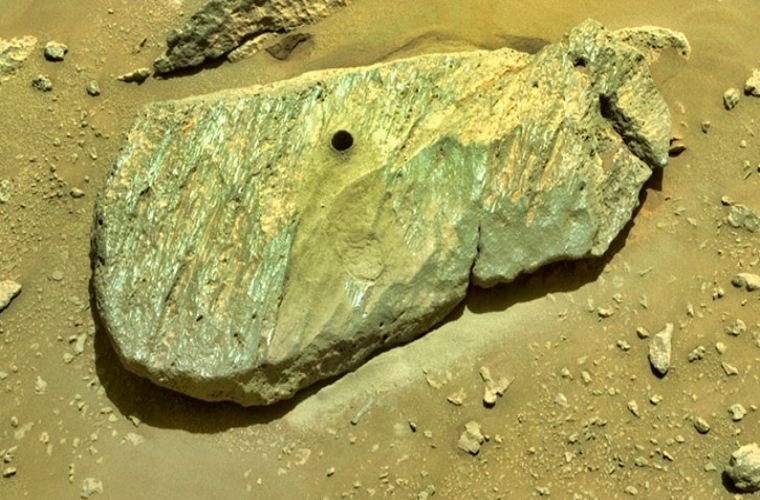Over the last three decades, a series of rovers and orbital satellites launched by the National Aeronautics and Space Administration (NASA) and the European Space Agency (ESA) have verified that Mars was once a much wetter place. However, none of those missions determined if these ancient Martian lakes were brief in nature, or if they remained in place long enough for microbial life to take hold.
Now, initial tests performed on the first two rock samples collected by NASA’s Perseverance rover reveal that the water in Jezero crater was likely on the red planet’s surface for a much longer time than first thought, perhaps hundreds or even thousands of years.
“It looks like our first rocks reveal a potentially habitable sustained environment,” said Ken Farley, project scientist for the mission, in a statement Friday. “It’s a big deal that the water was there for a long time.”
Background: Looking for Life in the Right Places
The first possible signs of microbial life on Mars were detected back in 1976 by NASA’s Viking 1 and Viking 2 landers. Failure to repeat the initial test’s positive results left a question as to the find’s authenticity, but as recently as 2019, a member of that original team Gilbert V. Levin wrote an opinion piece for Scientific American affirming his belief that what they found were signs of microbial life.
Rather than follow up on the Viking missions’ debatable results, NASA and the world’s other space agencies have spent the decades since slowly but surely building a nearly irrefutable case for a wet Martian past. With these latest test results, the Perseverance rover seems to have put the finishing touches on that case, showing definitively that Mars not only had water on its surface but also that these bodies of water likely lasted for centuries.
Analysis: Have We Found Life on Mars?
The first attempt by Perseverance to collect samples back in August failed due to the target rock being too crumbly for the rover’s drill. The two successfully collected samples, dubbed “Montagnac” and “Montdenier,” were scooped up on September 6th and September 8th respectively, and both have been cached inside the rover for a planned future sample return mission.
About six centimeters long, and slightly larger than a pencil, the two samples were taken from Jezero crater, the site of an ancient Martian lake that researchers believe existed about 3.5 billion years ago. However, until now they didn’t know if it had appeared briefly, less than 50 years, or remained in place for a significantly longer period of time. This latest test result confirms the latter, showing that Jezero’s lake was almost surely present for much, much longer.
“An interesting thing about these rocks…is that they show signs for sustained interaction with groundwater,” said NASA geologist Katie Stack Morgan at the press conference announcing the rover team’s tantalizing results.
At that same press conference, Stack Morgan also revealed that the tests performed by Perseverance indicate that the samples came from basaltic rock, which was likely made by ancient lava flows. This composition, Stack Morgan says, could mean that salt minerals within the rock cores might have trapped very small bubbles of ancient Martian water still waiting to be studied.
“Salts are great minerals for preserving signs of ancient life here on Earth,” said Stack Morgan, “and we expect the same may be true for rocks on Mars.”
Outlook: The Samples Need to Get To Earth
NASA and the ESA had already been working on a Mars Sample Return (MSR) mission to retrieve any theoretical samples collected by Perseverance, but the successful collection of Montagnac and Montdenier combined with the signs of long term water exposure detected in both only reaffirms the need to bring these and any future samples back to Earth for detailed study as soon as possible.
Most projections have MSR slated for the early 2030s, raising hopes that it may only be a decade before a laboratory here on Earth is able to confirm what many feel would be the biggest scientific discovery in human history; signs that life once existed elsewhere.
“If these rocks experienced water for long periods of time,” said Stack Morgan, further emphasizing this critical point, “there may be habitable niches within these rocks that could have supported ancient microbial life.”
Follow and connect with author Christopher Plain on Twitter: @plain_fiction
Don’t forget to follow us on Twitter, Facebook, and Instagram, to weigh in and share your thoughts. You can also get all the latest news and exciting feature content from The Debrief on Flipboard, and Pinterest. And subscribe to The Debrief YouTube Channel to check out all of The Debrief’s exciting original shows: DEBRIEFED: Digging Deeper with Cristina Gomez –Rebelliously Curious with Chrissy Newton

